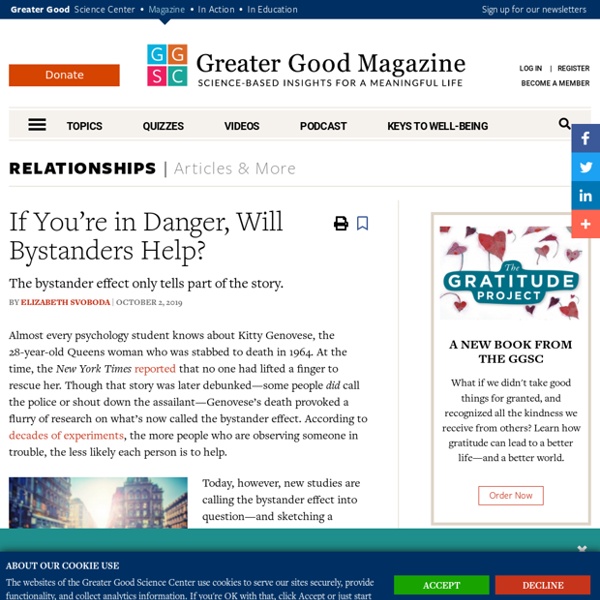If You’re in Danger, Will Bystanders Help?

https://greatergood.berkeley.edu/article/item/if_youre_in_danger_will_bystanders_help
Related: Ways to counteract the Bystander Effect
• Bystander effect
• Bystander effect and ways to counteract it
Are You a Hero or a Bystander?
We all wonder how we would react in an emergency. Would we risk our lives to help someone in danger? Laurie Ann Eldridge found out last year. Looking up from her garden one evening at her Cameron, N.Y., home, Ms.
Bystander effect – News, Research and Analysis – The Conversation – page 1
At least half of campus sexual assaults involve alcohol. But prevention programs at US colleges and universities don’t address what that means for bystanders. Incorporating lessons on healthy sexual behavior into sex ed classes and special prevention programs for youth could be key to reducing sexual violence, experts say. Research shows that few people take a stand when they witness sexual harassment. Until that changes, this predatory behavior will haunt American workplaces. A program developed by a University of Windsor professor significantly reduces a woman's risk of rape on campus.
From Empathy to Apathy: The Bystander Effect Revisited - Ruud Hortensius, Beatrice de Gelder, 2018
When people are asked whether they would spontaneously assist a person in an emergency situation, almost everyone will reply positively. Although we all imagine ourselves heroes, the fact is that many people refrain from helping in real life, especially when we are aware that other people are present at the scene. In the late 1960s, John M.
Psychology of the Bystander and tips for increasing chances of receiving help - Fight Times Magazine
Will I intervene? Bystanders must weigh the costs or dangers of intervening. Will I be harmed?
The legend of Kitty Genovese and those who ignored her screams
When I was growing up in New York City, everyone knew about Kitty Genovese. We all knew the story of the 28-year-old bar manager who had been robbed, raped and stabbed to death outside her apartment building in Queens in 1964 while 38 people watched or listened to her screams outside their apartments but did nothing to stop the attack. It was more than just another tabloid murder; it was a morality tale — exhibit A for the argument that cities were alienating and dehumanizing, that there was no such thing as neighborhood or community, that people were cold, cruel, selfish, indifferent. Even today, Kitty Genovese’s name is still invoked not just in New York but around the world when people fail to come to each other’s aid in times of violence and trouble. Thirty-eight witnesses, the New York Times said, and no one did anything over the 35 minutes the attack was taking place. Not one called the police while it was underway, even though Genovese was screaming, “Please help me.
10 Notorious Cases of the Bystander Effect
The bystander effect is the somewhat controversial name given to a social psychological phenomenon in cases where individuals do not offer help in an emergency situation when other people are present. The probability of help has in the past been thought to be inversely proportional to the number of bystanders. In other words, the greater the number of bystanders, the less likely it is that any one of them will help. This list describes the prototype of the effect and cites nine particularly heinous examples. The Parable of The Good Samaritan First, the prototype of the bystander effect.
Anticipated Guilt for Not Helping and ...
Introduction Imagine that you hear that the blood-supplies are running low in all hospitals in your part of the country. You know that you could help by visiting the nearby donor clinic on your way back from work and donate blood (it would take you around 30 min). Now imagine a similar situation, but where the donor clinic is located far away (it would take you around 4 h to go there and donate blood). How would you feel in both these situations in case you decided to help, or in case you decided not to help?
Bystander Effect - IResearchNet
Bystander Effect Definition Individuals who see or hear an emergency (but are otherwise uninvolved) are called bystanders. The bystander effect describes the phenomenon in which such individuals are less likely to seek help or give assistance when others are present.
Reducing the Bystander Effect
As discussed, there are a number of factors that magnify the Bystander Effect. Fortunately, there are also a number of factors that weaken it. Once again, factors can be divided into characteristics of the situation, and of the people. Situational characteristics
Related:



